
Richen Xiong
November 21, 2025
Collective spin-valley modes in twisted bilayer WSe2: moire superlattices, intervalley coherence and spin superfluid
Abstract: Quantum transport of charge has revealed a wealth of quantum phases, yet many other exotic quantum states in 2D flatland host charge-neutral modes, remaining challenging to probe transport experimentally. One example Is intervalley coherent states a unifying theme in graphene and semiconductor moire systems, predicted to host a neutral Goldstone mode arising from spontaneously broken valley U(1) symmetry. Here we directly image the transport of collective spin-valley modes in twisted WSe2 using an ultrafast imaging technique. Near the van Hove singularity, we uncover two new collective modes. One mode propagates at a large speed of ~3 km/s and is consistent with the Goldstone mode, while the slower mode is likely a gapped excitation. These can be interpreted as the phase and amplitude modes of a spin-valley superfluid. Our study opens new opportunities to study the transport of charge neutral modes in condensed matter systems.

Eber Nolasco-Martinez
Friday, November 7, 2025
Continuous Trapped Atom Interferometry with Magic Floquet-Bloch Bands
Abstract: I am a graduate student in David Weld's group working on the Lithium experiment, where we explore the dynamics of ultracold atoms in a driven optical lattice. In this talk I will discuss how we use AMO techniques to cool down Lithium to nK temperatures and perform simulation experiments in optical lattices. I will also talk about our recent results in utilizing an amplitude-modulated lattice to build a continuously trapped interferometer, where by having atoms Bloch oscillate and enter a superposition of two bands, we can observe spatial separation and use the interference of the two arms as a local force sensor. In addition,we can use multiple frequencies in our drive to tune and control our bands to modify. their properties and the sensitivity of our interferometer. This experiment lies in the interface of condensed matter ideas and precision measurement techniques, showing how interrelated ideas can connect to improve technology.
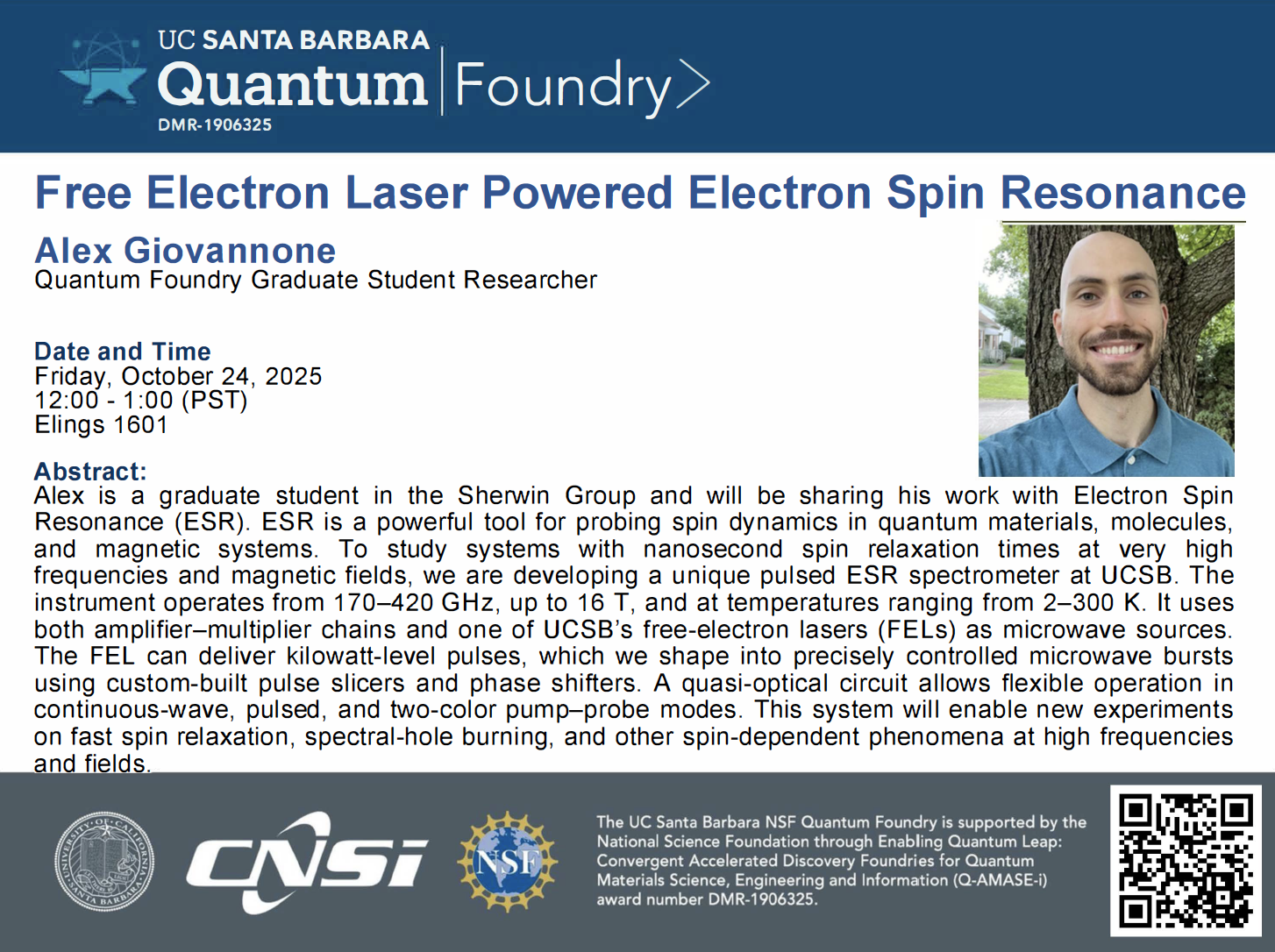
Alex Giovannone
Free Electron Laser Powered Electron Spin Resonance
Friday, October 24, 2025
Alex is a graduate student in the Sherwin Group and will be sharing his work with Electron Spin Resonance (ESR). ESR is a powerful tool for probing spin dynamics in quantum materials, molecules, and magnetic systems. To study systems with nanosecond spin relaxation times at very high frequencies and magnetic fields, we are developing a unique pulsed ESR spectrometer at UCSB. The instrument operates from 170-420 GHz, up to 16 T, and at temperatures ranging from 2-300 K. It uses both amplifier-multiplier chains and one of UCSB's free-electron lasers (FELs) as microwave sources. The FEL can deliver kilowatt-level pulses, which we shape into precisely controlled microwave bursts using custom-built pulse slicers and phase shifters. A quasi-optical circuit allows flexible operation in continuous-wave, pulsed, and two-color pump-probe modes. This system will enable new experiments on fast spin relaxation, spectral-hole burning, and other spin-dependent phenomena at high frequencies and fields.
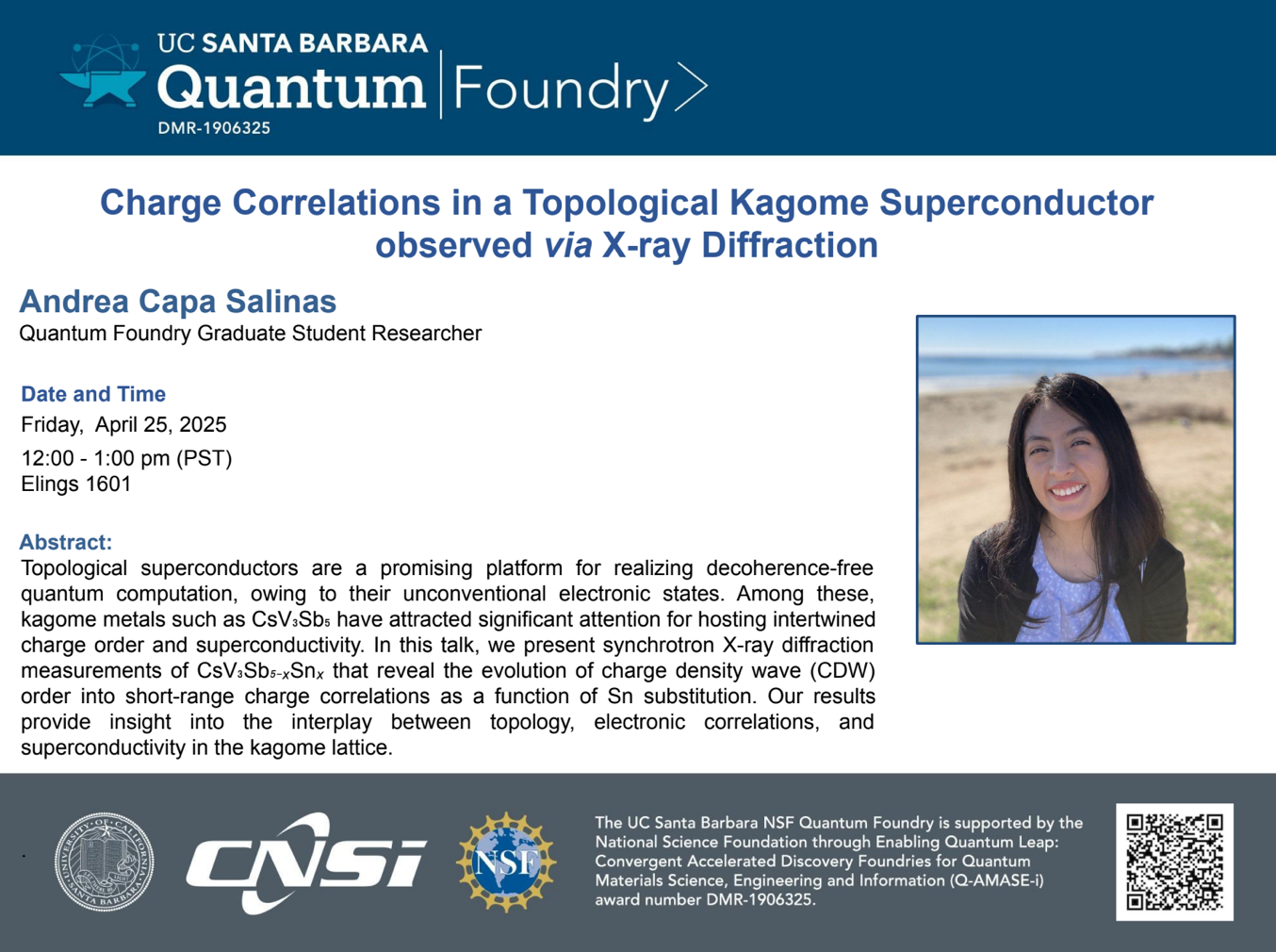
Andrea Capa Salinas
Date: April 25, 2025
Charge Correlations in a Topological Kagome Superconductor observed via X-ray Diffraction
Topological superconductors are a promising platform for realizing decoherence-free
quantum computation, owing to their unconventional electronic states. Among these,
kagome metals such as CsV3Sb5 have attracted significant attention for hosting intertwined
charge order and superconductivity. In this talk, we present synchrotron X-ray diffraction
measurements of CsV3Sb5−xSnx that reveal the evolution of charge density wave (CDW)
order into short-range charge correlations as a function of Sn substitution. Our results
provide insight into the interplay between topology, electronic correlations, and
superconductivity in the kagome lattice.
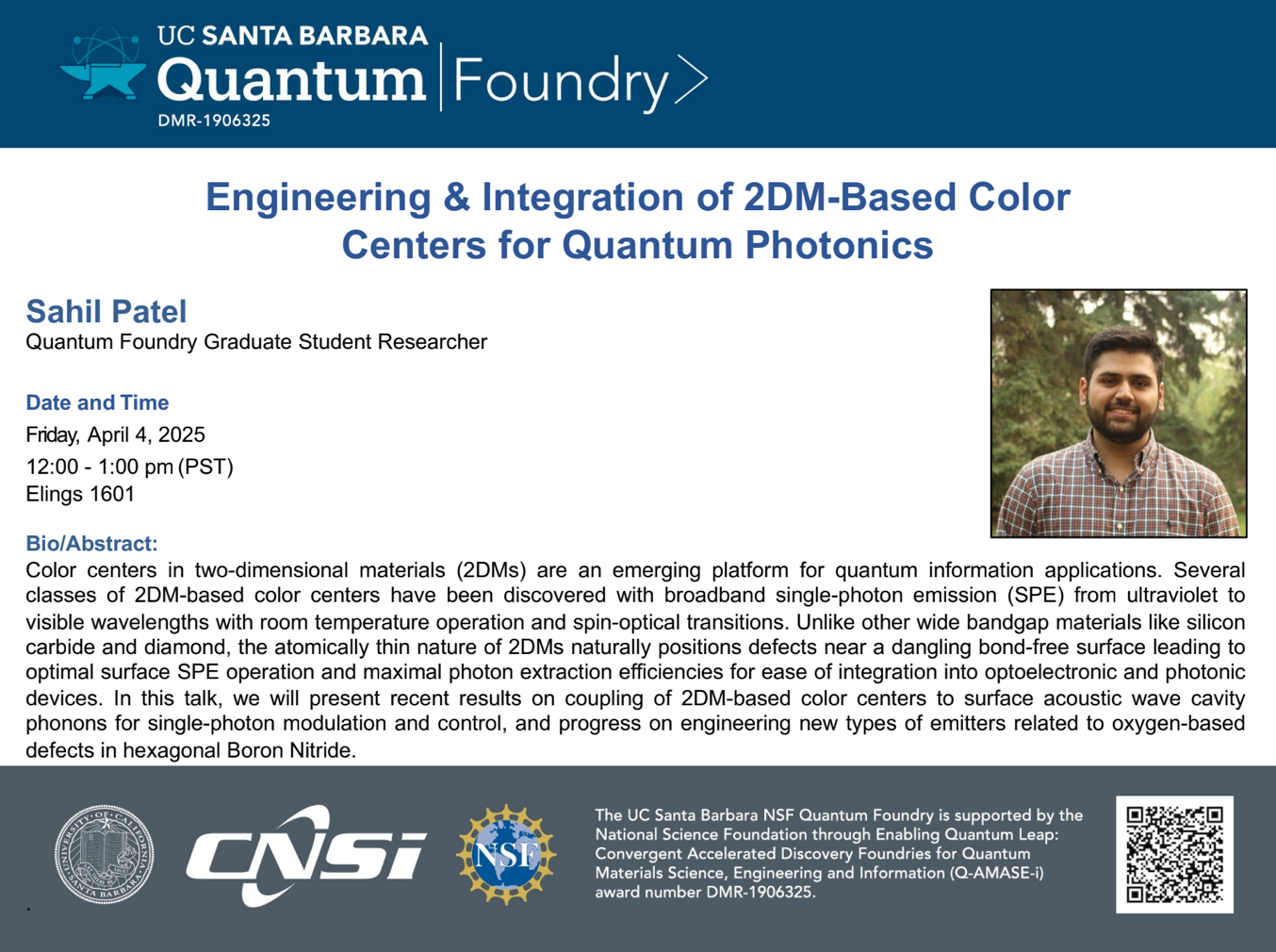
Sahil Patel
Date: April 4, 2025
Engineering & Integration of 2DM-Based Color Centers for Quantum Photonics
Color centers in two-dimensional materials (2DMs) are an emerging platform for quantum information applications. Several classes of 2DM-based color centers have been discovered with broadband single-photon emission (SPE) from ultraviolet to visible wavelengths with room temperature operation and spin-optical transitions. Unlike other wide bandgap materials like silicon carbide and diamond, the atomically thin nature of 2DMs naturally positions defects near a dangling bond-free surface leading to optimal surface SPE operation and maximal photon extraction efficiencies for ease of integration into optoelectronic and photonic devices. In this talk, we will present recent results on coupling of 2DM-based color centers to surface acoustic wave cavity phonons for single-photon modulation and control, and progress on engineering new types of emitters related to oxygen-based defects in hexagonal Boron Nitride.
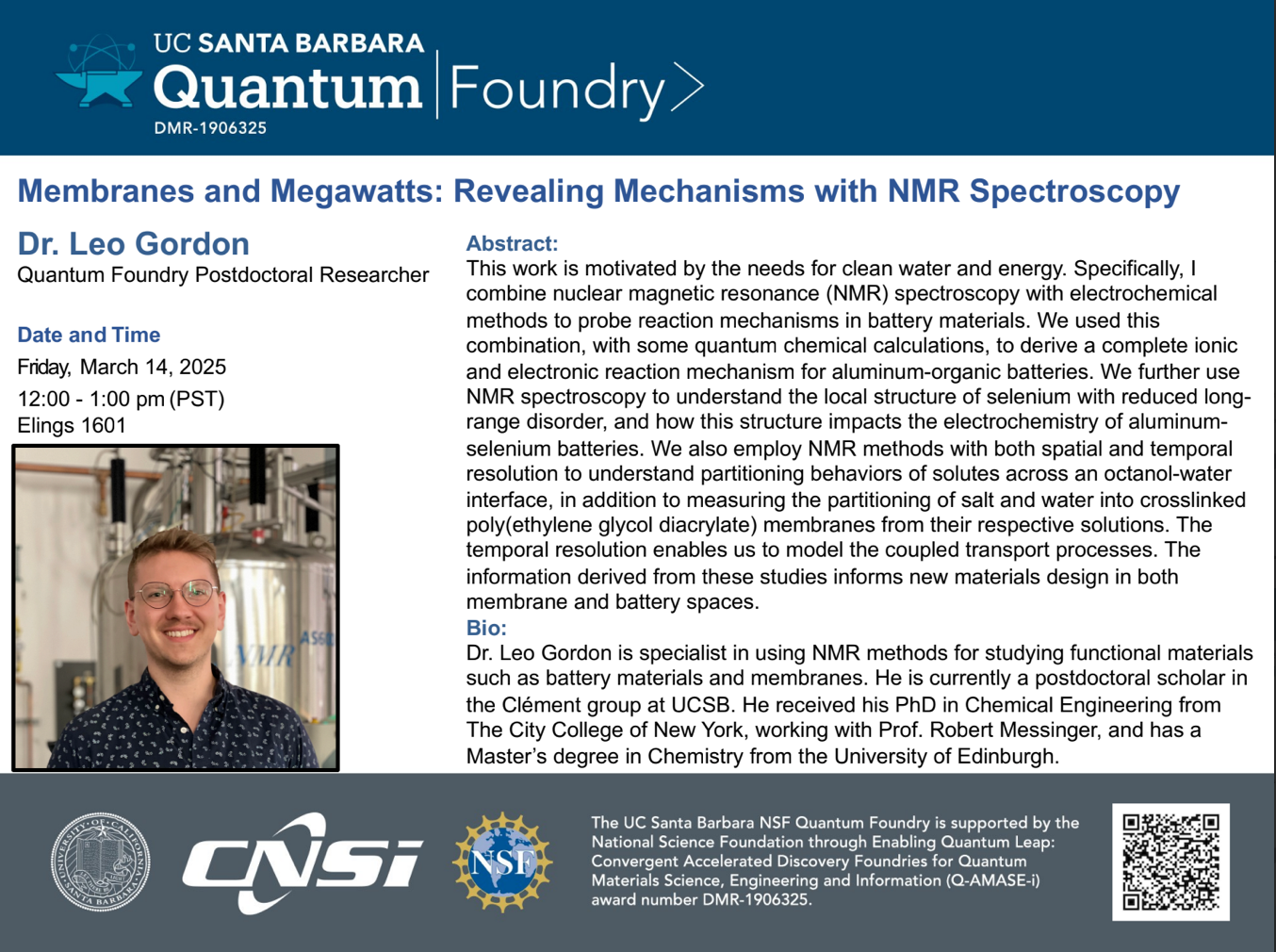
Dr. Leo Gordon
Date: March 14, 2025
Membranes and Megawatts: Revealing Mechanisms with NMR Spectroscopy
This work is motivated by the needs for clean water and energy. Specifically, I combine nuclear magnetic resonance (NMR) spectroscopy with electrochemical methods to probe reaction mechanisms in battery materials. We used this combination, with some quantum chemical calculations, to derive a complete ionic and electronic reaction mechanism for aluminum-organic batteries. We further use NMR spectroscopy to understand the local structure of selenium with reduced long-range disorder, and how this structure impacts the electrochemistry of aluminum-selenium batteries. We also employ NMR methods with both spatial and temporal resolution to understand partitioning behaviors of solutes across an octanol-water interface, in addition to measuring the partitioning of salt and water into crosslinked poly(ethylene glycol diacrylate) membranes from their respective solutions. The temporal resolution enables us to model the coupled transport processes. The information derived from these studies informs new materials design in both membrane and battery spaces.
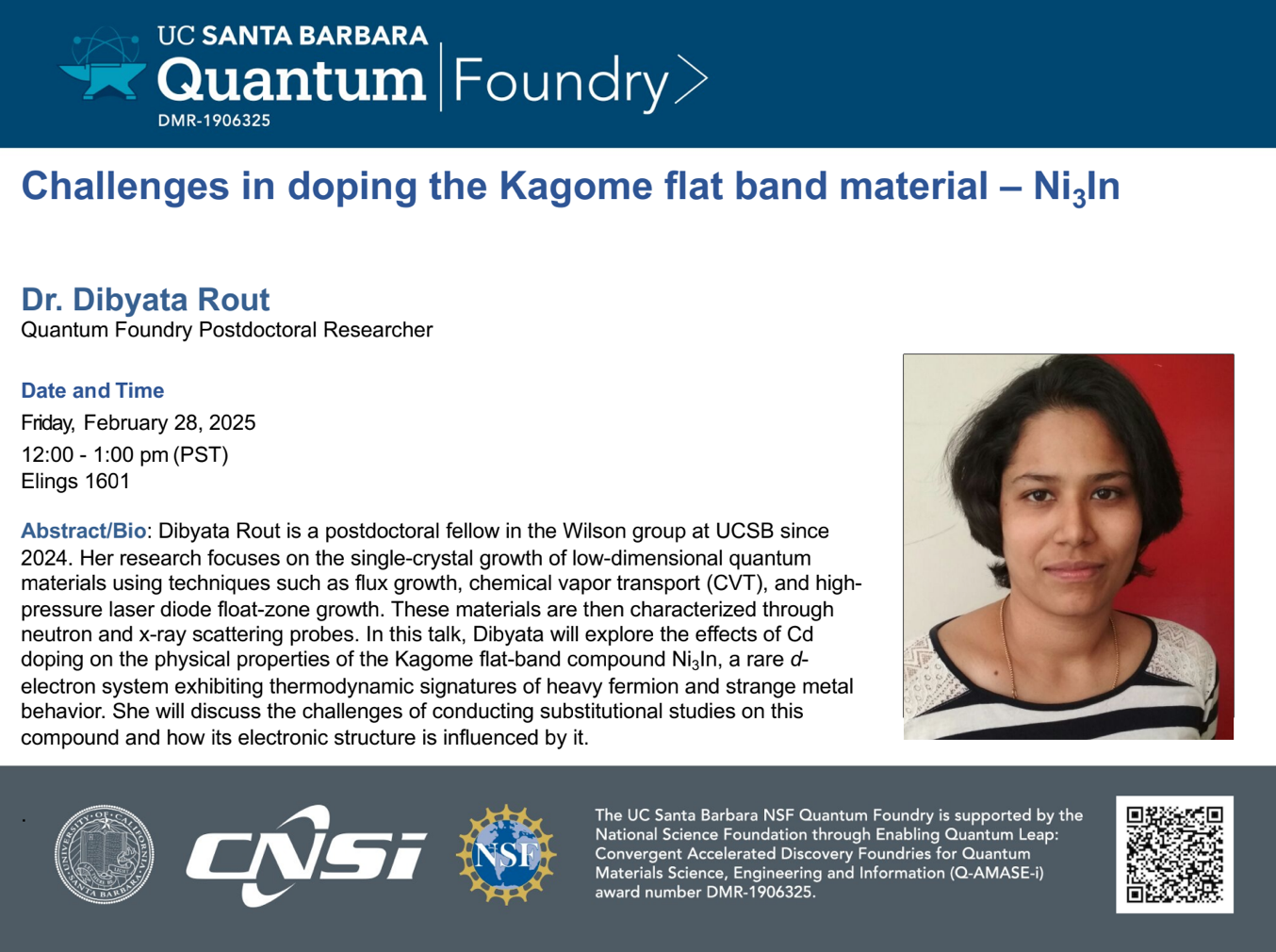
Dr. Dibyata Rout
Date: February 28, 2025
Challenges in doping the Kagome flat band material – Ni3In
Dibyata Rout is a postdoctoral fellow in the Wilson group at UCSB since 2024. Her research focuses on the single-crystal growth of low-dimensional quantum materials using techniques such as flux growth, chemical vapor transport (CVT), and high-pressure laser diode float-zone growth. These materials are then characterized through neutron and x-ray scattering probes. In this talk, Dibyata will explore the effects of Cd doping on the physical properties of the Kagome flat-band compound Ni3In, a rare d-electron system exhibiting thermodynamic signatures of heavy fermion and strange metal behavior. She will discuss the challenges of conducting substitutional studies on this compound and how its electronic structure is influenced by it.
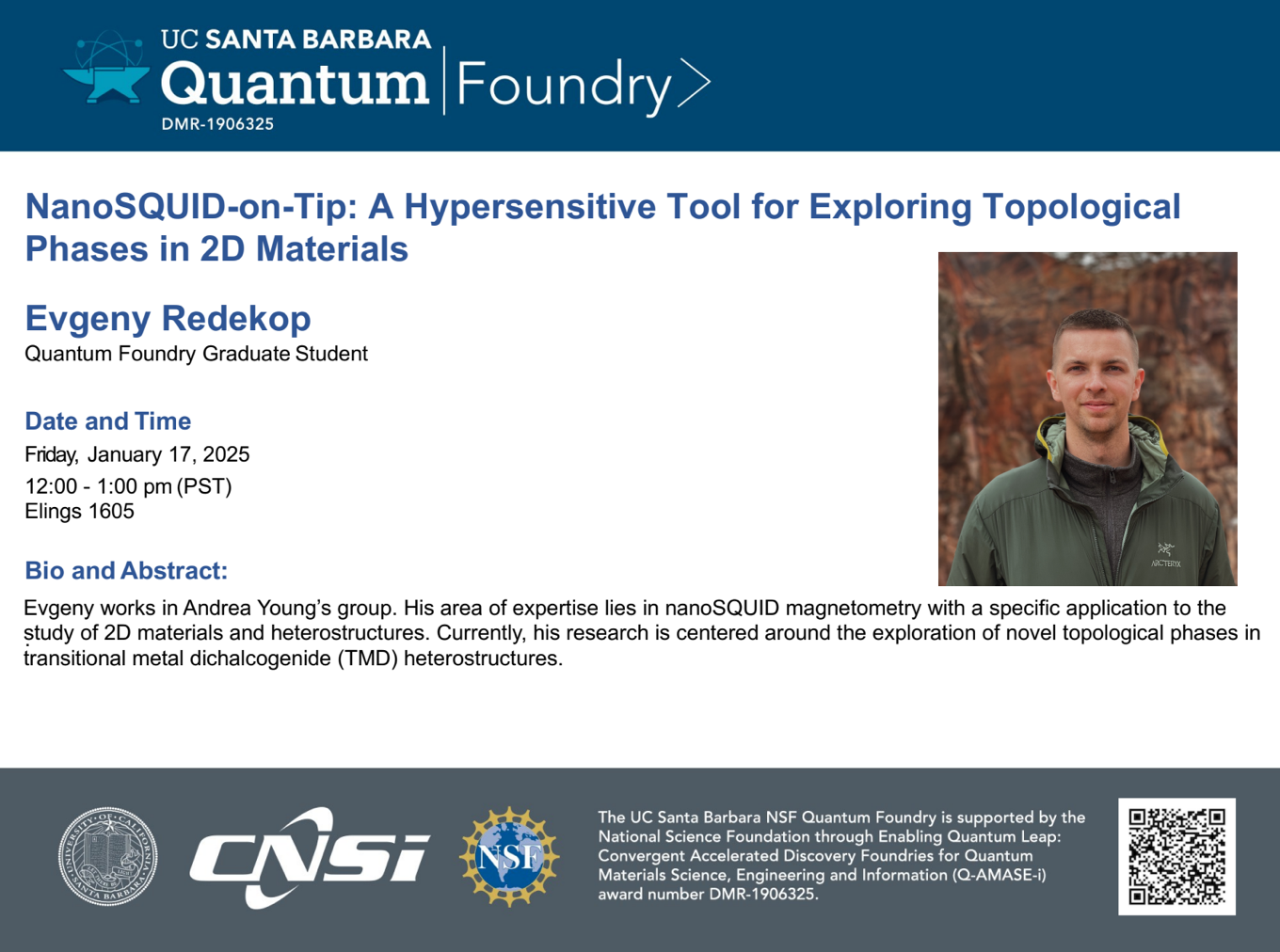
Evgeny Redekop
Date: January 17, 2025
NanoSQUID-on-Tip: A Hypersensitive Tool for Exploring Topological Phases in 2D Materials
Evgeny works in Andrea Young's aroup. His area of expertise lies in nanoSQUID maanetometry with a specific application to the stud of 2D materials and heterostructures. Currentlv, his research is centered around the exploration of novel topoloaical phases intransitional metal dichalcogenide (MD) heterostructures.
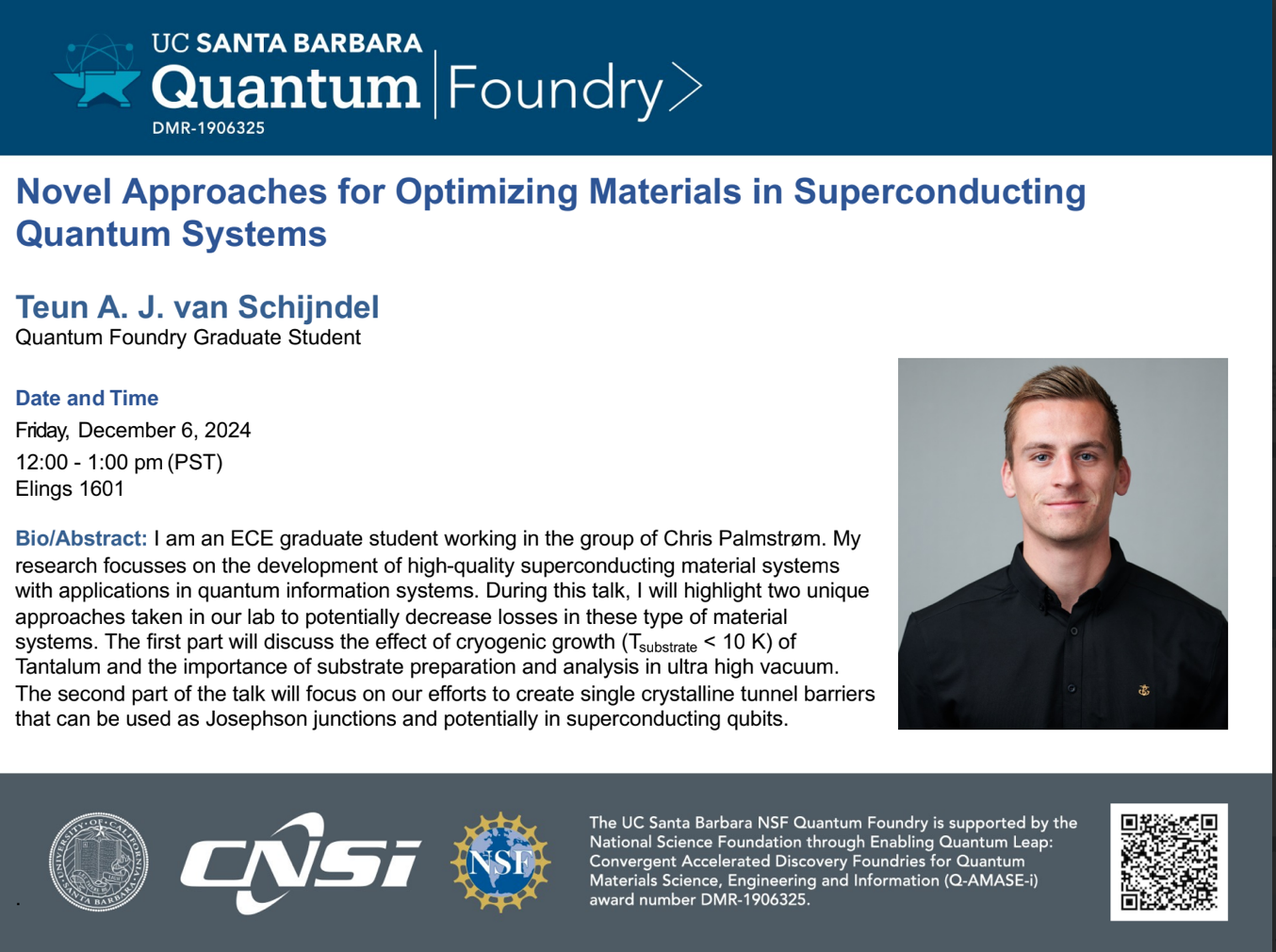
Teun A. J. van Schijndel
Date: December 6, 2024
Novel Approaches for Optimizing Materials in Superconducting Quantum Systems
I am an ECE graduate student working in the group of Chris Palmstrøm. My research focusses on the development of high-quality superconducting material systems with applications in quantum information systems. During this talk, I will highlight two unique approaches taken in our lab to potentially decrease losses in these type of material systems. The first part will discuss the effect of cryogenic growth (Tsubstrate < 10 K) of Tantalum and the importance of substrate preparation and analysis in ultra high vacuum. The second part of the talk will focus on our efforts to create single crystalline tunnel barriers
that can be used as Josephson junctions and potentially in superconducting qubits.
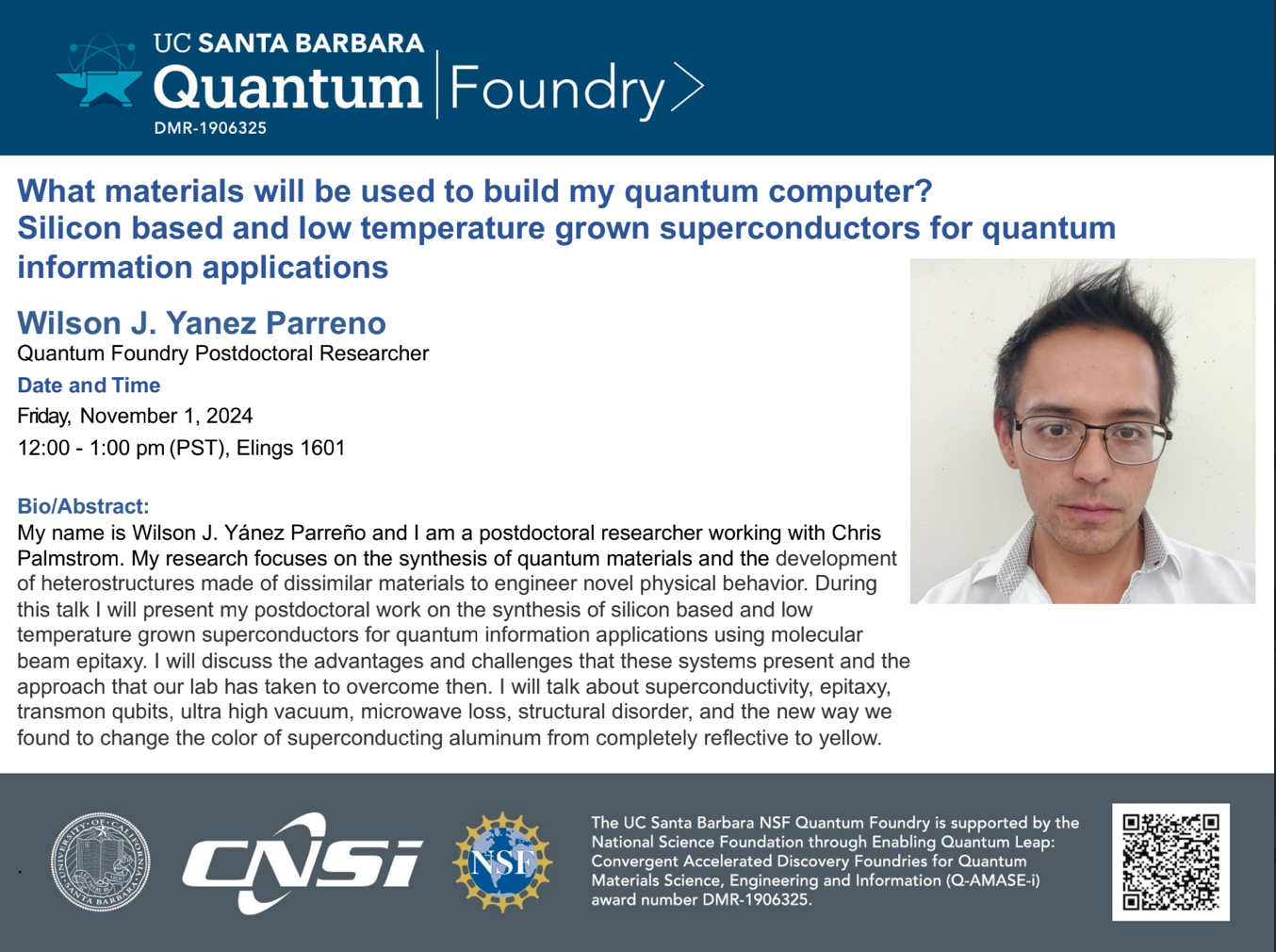
Wilson J. Yanez Parreno
Date: November 1, 2024
What materials will be used to build my quantum computer? Silicon based and low temperature grown superconductors for quantum information applications
My name is Wilson J. Yánez Parreño and I am a postdoctoral researcher working with Chris Palmstrom. My research focuses on the synthesis of quantum materials and the development of heterostructures made of dissimilar materials to engineer novel physical behavior. During this talk I will present my postdoctoral work on the synthesis of silicon based and low temperature grown superconductors for quantum information applications using molecular beam epitaxy. I will discuss the advantages and challenges that these systems present and the approach that our lab has taken to overcome then. I will talk about superconductivity, epitaxy, transmon qubits, ultra high vacuum, microwave loss, structural disorder, and the new way we found to change the color of superconducting aluminum from completely reflective to yellow.
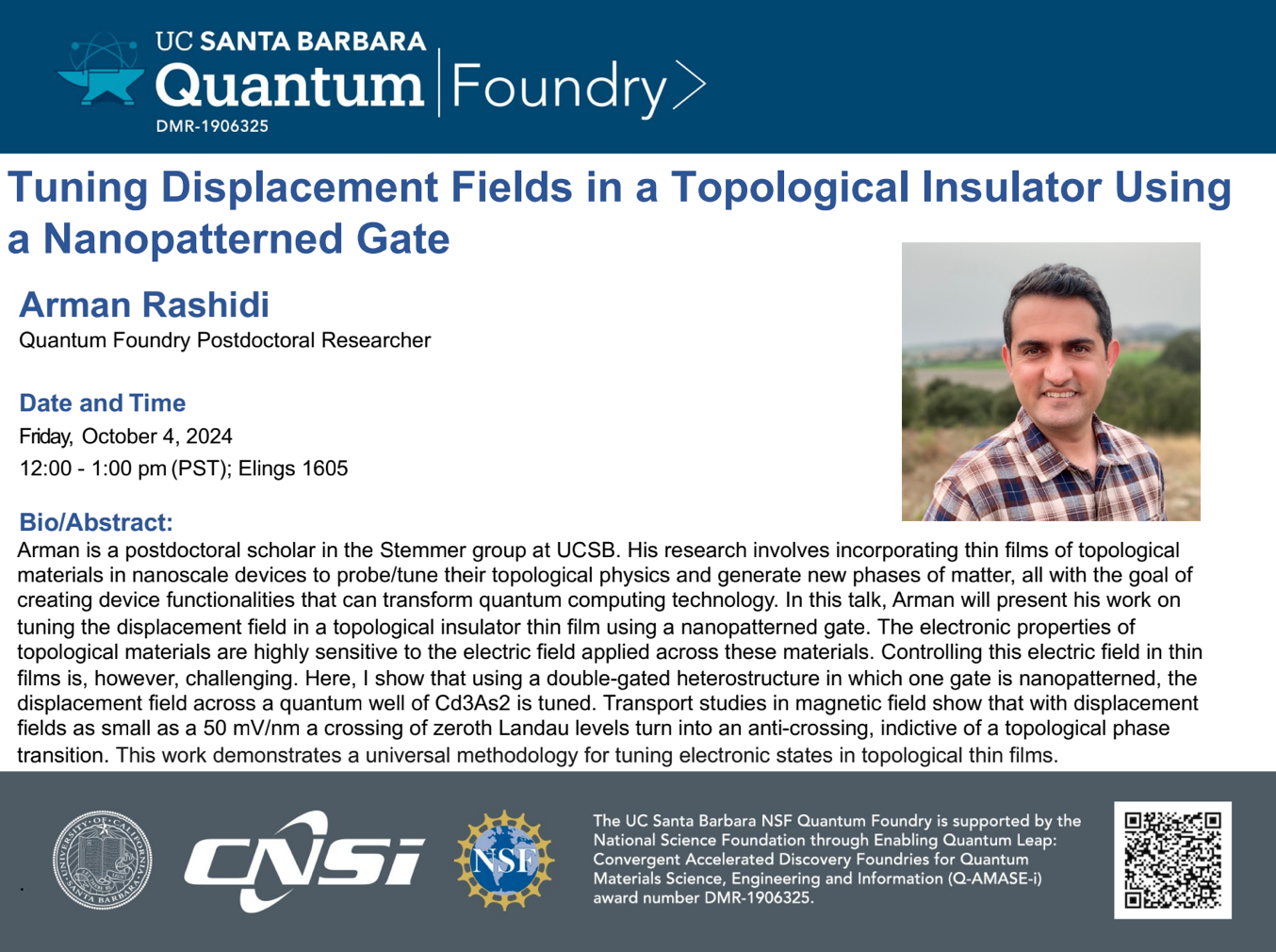
Arman Rashidi
Date: October 4, 2024
Tuning Displacement Fields in a Topological Insulator Using a Nanopatterned Gate
Arman is a postdoctoral scholar in the Stemmer group at UCSB. His research involves incorporating thin films of topological materials in nanoscale devices to probe/tune their topological physics and generate new phases of matter, all with the goal of creating device functionalities that can transform quantum computing technology. In this talk, Arman will present his work on tuning the displacement field in a topological insulator thin film using a nanopatterned gate. The electronic properties of topological materials are highly sensitive to the electric field applied across these materials. Controlling this electric field in thin films is, however, challenging. Here, I show that using a double-gated heterostructure in which one gate is nanopatterned, the displacement field across a quantum well of Cd3As2 is tuned. Transport studies in magnetic field show that with displacement fields as small as a 50 mV/nm a crossing of zeroth Landau levels turn into an anti-crossing, indictive of a topological phase transition. This work demonstrates a universal methodology for tuning electronic states in topological thin films.
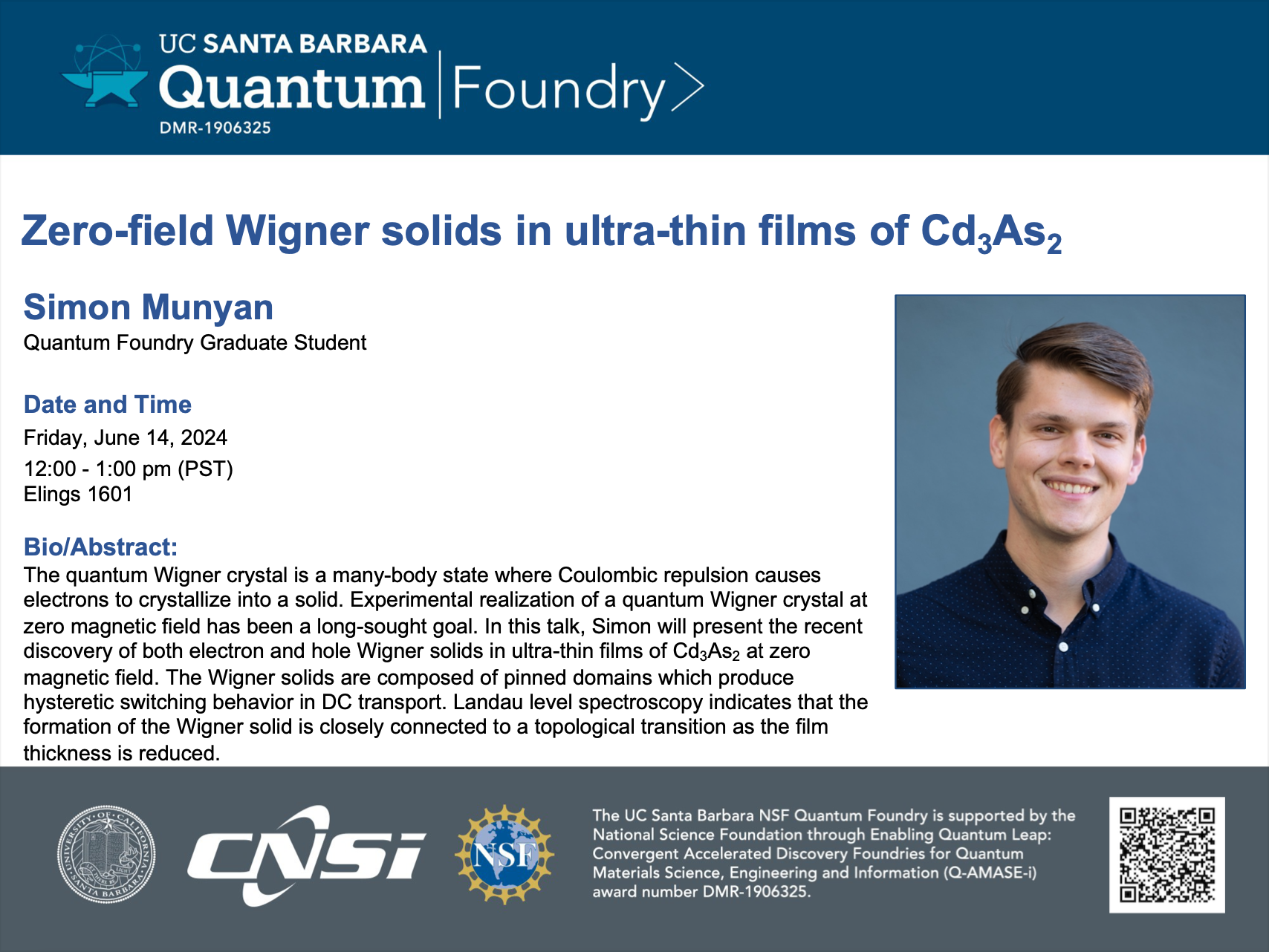
Simon Munyan
Date: June 14, 2024
Zero-field Wigner solids in ultra-thin films of Cd3As2
The quantum Wigner crystal is a many-body state where Coulombic repulsion causes
electrons to crvstallize into a solid. Experimental realization of a quantum Wigner crystal at
zero magnetic field has been a long-sought goal. In this talk, Simon will present the recent
discovery of both electron and hole Wigner solids in ultra-thin films of Cd.As, at zero
magnetic field. The Wigner solids are composed of pinned domains which produce
hysteretic switching behavior in DC transport. Landau level spectroscopy indicates that the
formation of the Wigner solid is closely connected to a topological transition as the film
thickness is reduced
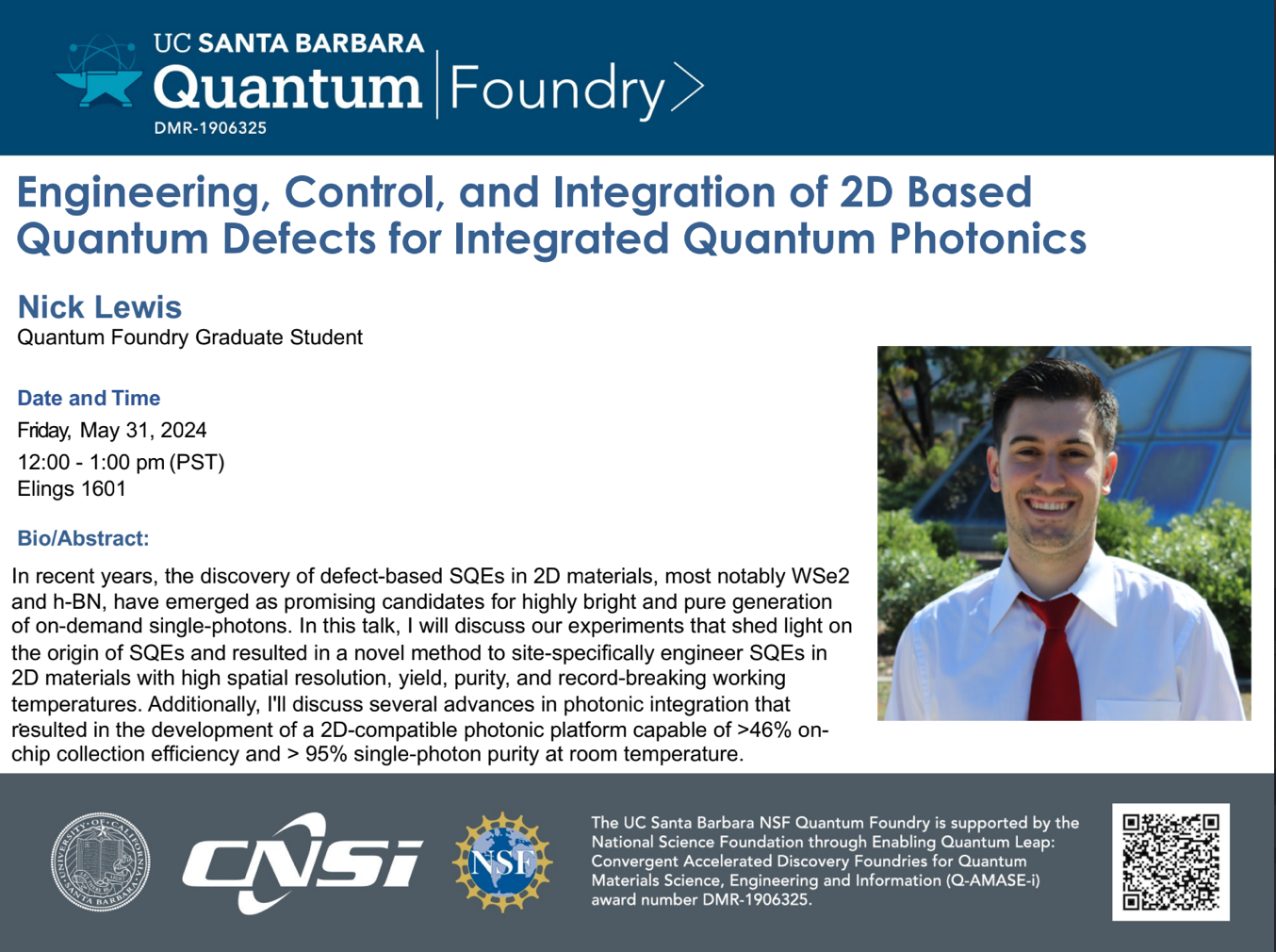
Nick Lewis
Date: May 21, 2024
Engineering, Control, and Integration of 2D Based Quantum Defects for Integrated Quantum Photonics
In recent years, the discovery of defect-based SQEs in 2D materials, most notably WSe2 and h-BN, have emerged as promising candidates for highly bright and pure generation of on-demand single-photons. In this talk, I will discuss our experiments that shed light on the origin of SQEs and resulted in a novel method to site-specifically engineer SQEs in 2D materials with high spatial resolution, yield, purity, and record-breaking working temperatures. Additionally, I'll discuss several advances in photonic integration that resulted in the development of a 2D-compatible photonic platform capable of >46% on- chip collection efficiency and > 95% single-photon purity at room temperature.
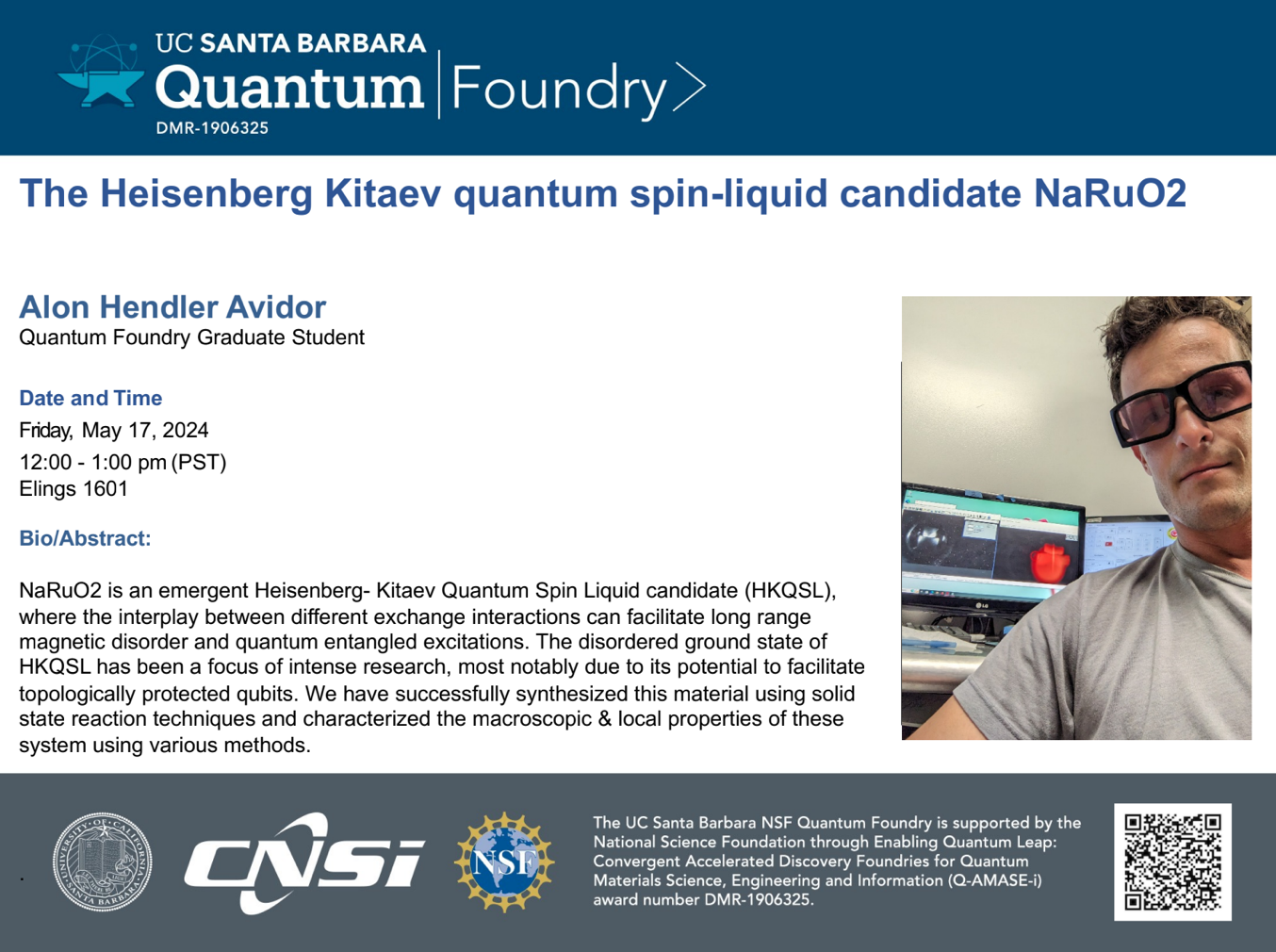
Alon Hendle Avidor
Date: May 17, 2024
The Heisenberg Kitaev quantum spin-liquid candidate NaRuO2
NaRuO2 is an emergent Heisenberg- Kitaev Quantum Spin Liquid candidate (HKQSL), where the interplay between different exchange interactions can facilitate long range magnetic disorder and quantum entangled excitations. The disordered ground state of HKQSL has been a focus of intense research, most notably due to its potential to facilitate topologically protected qubits. We have successfully synthesized this material using solid state reaction techniques and characterized the macroscopic & local properties of these system using various methods.
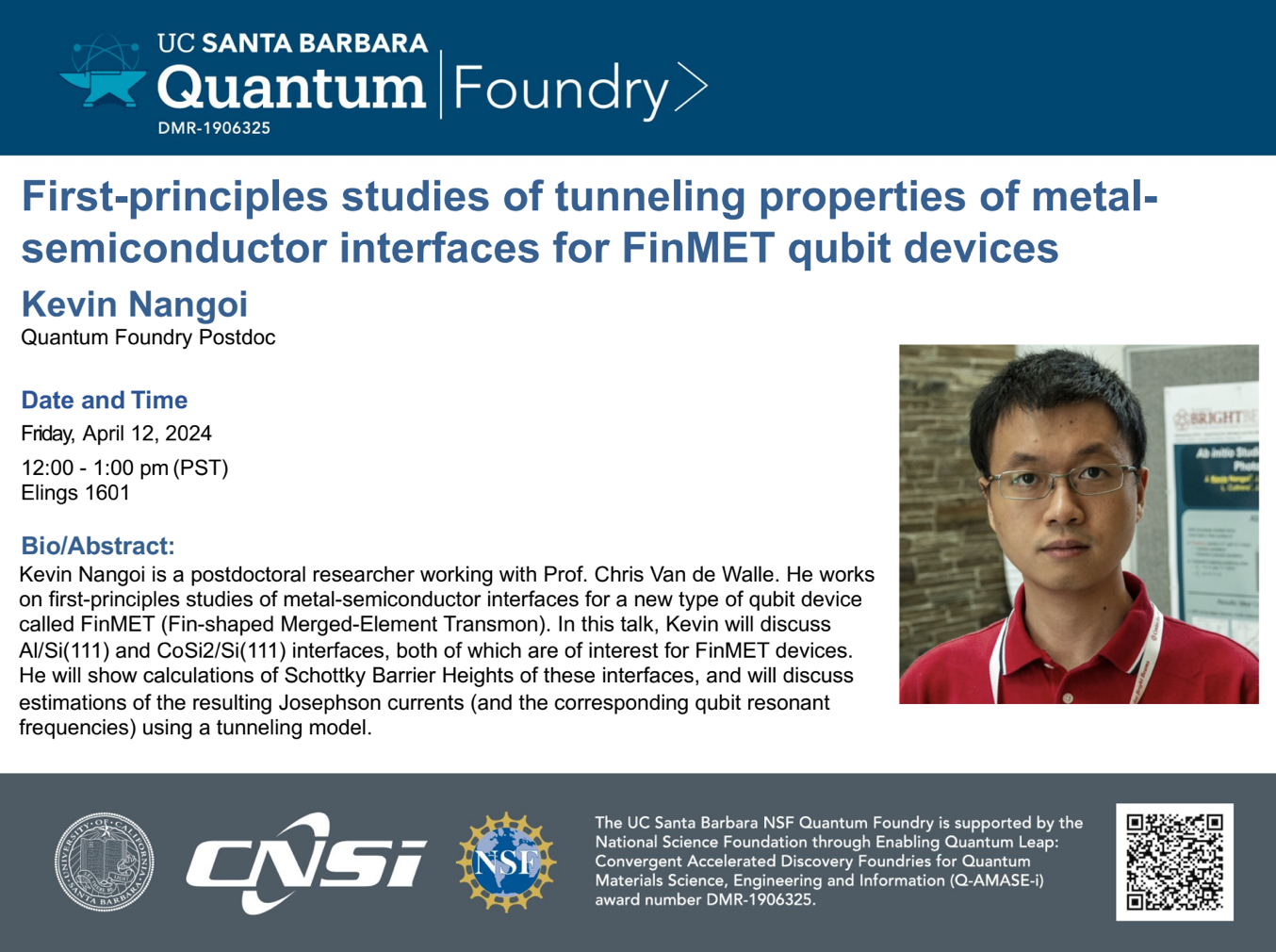
Kevin Nangoi
Date: April 12, 2024
First-principles studies of tunneling properties of metal-semiconductor interfaces for FinMET qubit devices
Kevin Nangoi is a postdoctoral researcher working with Prof. Chris Van de Walle. He works on first-principles studies of metal-semiconductor interfaces for a new type of qubit device called FinMET (Fin shaped Merged-Element Transmon). In this talk, Kevin will discuss Al/Si(111) and CoSi2/Si(111) interfaces, both of which are of interest for FinMET devices. He will show calculations of Schottky Barrier Heights of these interfaces, and will discuss estimations of the resulting Josephson currents (and the corresponding qubit resonant frequencies) using a tunneling model.
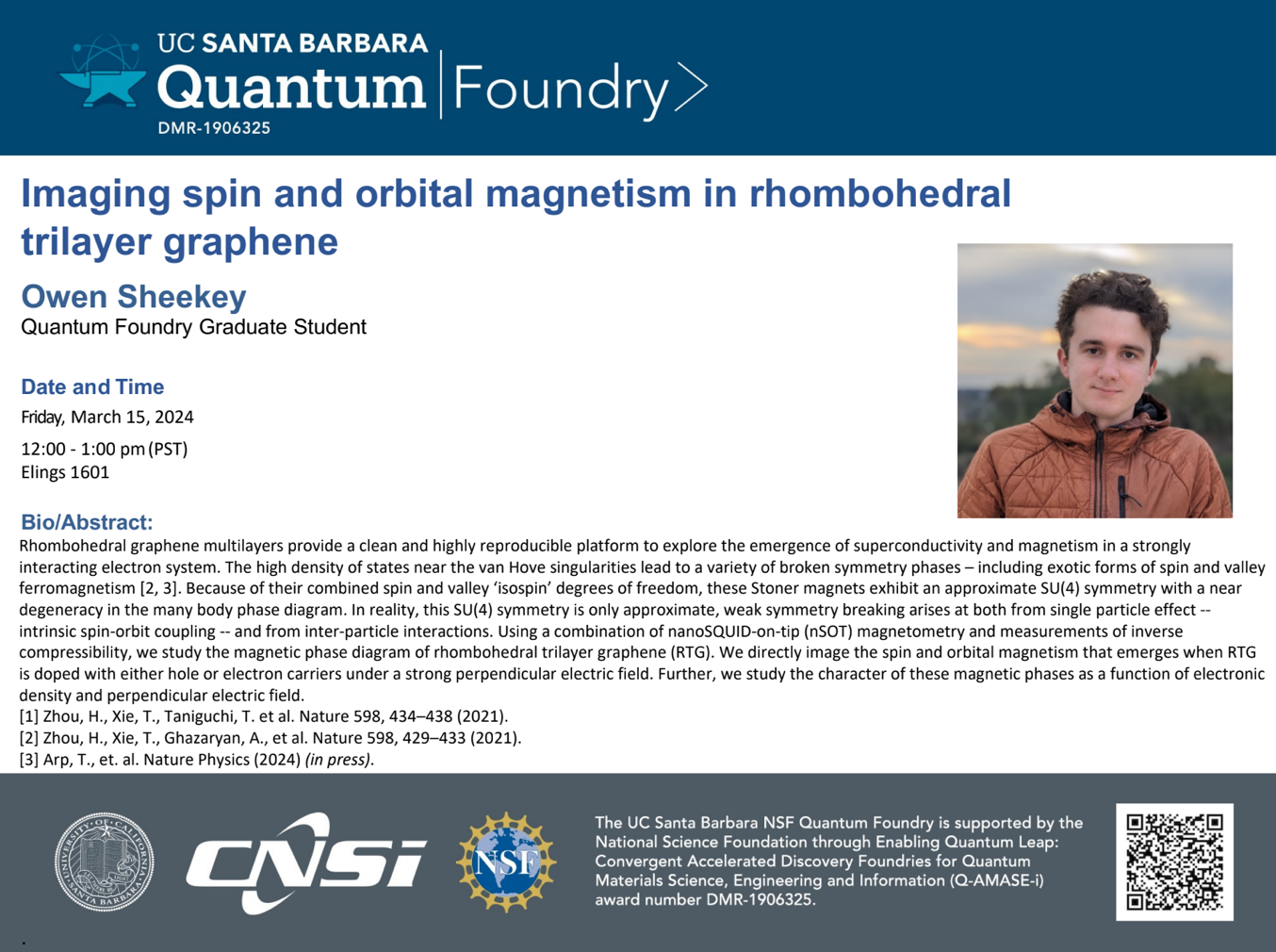
Owen Sheekey
Date: March 15, 2024
Imaging spin and orbital magnetism in rhombohedral trilayer graphene
Rhombohedral graphene multilayers provide a clean and highly reproducible platform to explore the emergence of superconductivity and magnetism in a strongly interacting electron system. The high density of states near the van Hove singularities lead to a variety of broken symmetry phases – including exotic forms of spin and valley ferromagnetism [2, 3]. Because of their combined spin and valley ‘isospin’ degrees of freedom, these Stoner magnets exhibit an approximate SU(4) symmetry with a near
degeneracy in the many body phase diagram. In reality, this SU(4) symmetry is only approximate, weak symmetry breaking arises at both from single particle effect -- intrinsic spin-orbit coupling -- and from inter-particle interactions. Using a combination of nanoSQUID-on-tip (nSOT) magnetometry and measurements of inverse compressibility, we study the magnetic phase diagram of rhombohedral trilayer graphene (RTG). We directly image the spin and orbital magnetism that emerges when RTG is doped with either hole or electron carriers under a strong perpendicular electric field. Further, we study the character of these magnetic phases as a function of electronic density and perpendicular electric field.
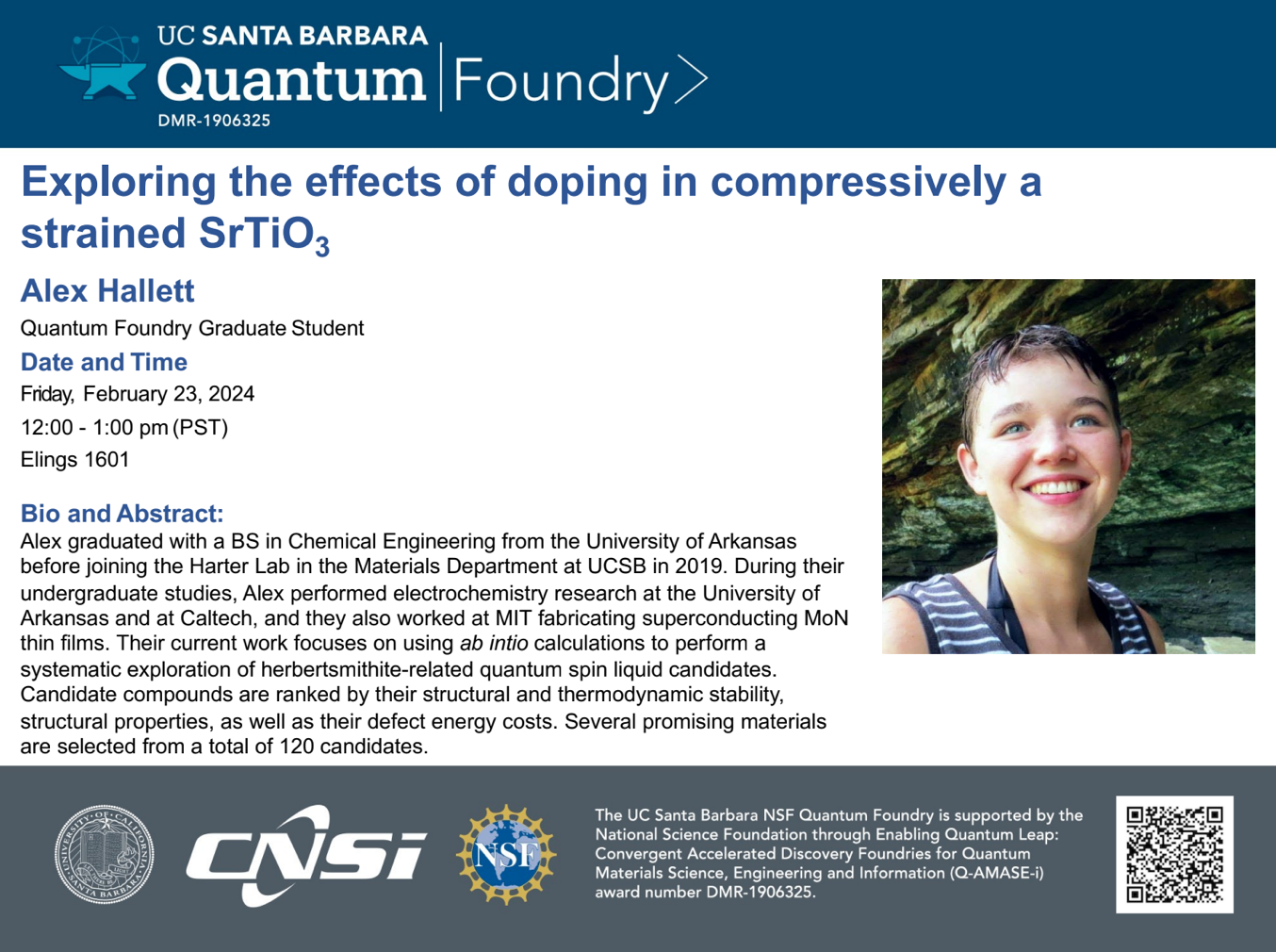
Alex Hallett
Date: February 23, 2024
Exploring the effects of doping in compressively a strained SrTiO3
Alex graduated with a BS in Chemical Engineering from the University of Arkansas
before joining the Harter Lab in the Materials Department at UCSB in 2019. During their
undergraduate studies, Alex performed electrochemistry research at the University of
Arkansas and at Caltech, and they also worked at MIT fabricating superconducting MoN
thin films. Their current work focuses on using ab intio calculations to perform a
systematic exploration of herbertsmithite-related quantum spin liquid candidates.
Candidate compounds are ranked by their structural and thermodynamic stability,
structural properties, as well as their defect energy costs. Several promising materials
are selected from a total of 120 candidates.
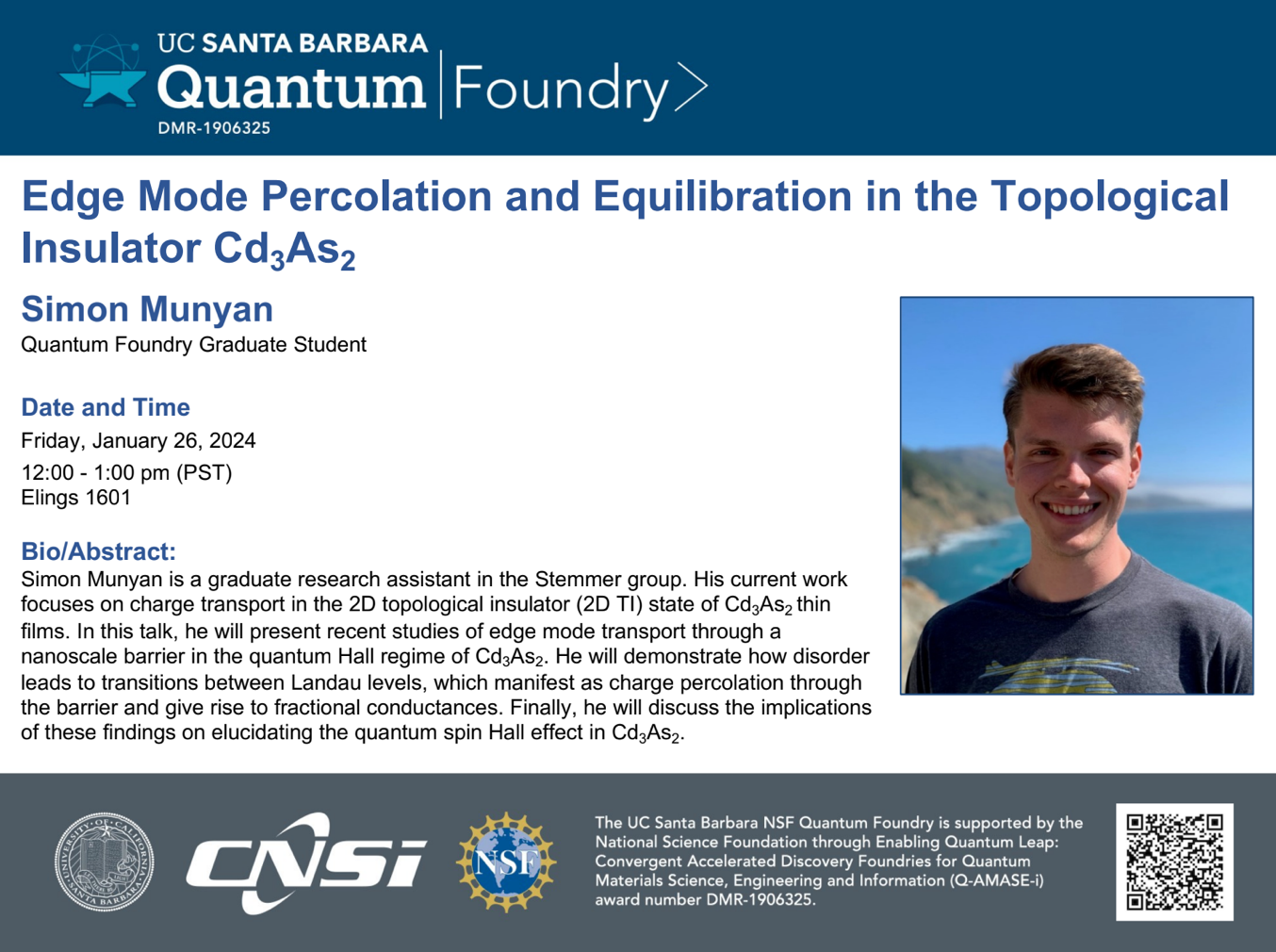
Simon Munyan
Date: January 26, 2024
Edge Mode Percolation and Equilibration in the Topological Insulator Cd3As2
Simon Munyan is a graduate research assistant in the Stemmer group. His current work focuses on charge transport in the 2D topological insulator (2D TI) state of Cd3As2 thin films. In this talk, he will present recent studies of edge mode transport through a nanoscale barrier in the quantum Hall regime of Cd3As2. He will demonstrate how disorder leads to transitions between Landau levels, which manifest as charge percolation through the barrier and give rise to fractional conductances. Finally, he will discuss the implications of these findings on elucidating the quantum spin Hall effect in Cd3As2.

Steven Gomez Alvarado
Date: January 12, 2024
3D-ΔPDF analysis of short-range charge order in LnCd3P3 (Ln = La, Ce, Pr, Nd)
Steven received his B.S. in Chemical Engineering from UCLA in 2018. Prior to arriving at
UCSB, he spent several years investigating novel thermoelectric materials at NASA’s Jet
Propulsion Laboratory. He now works under Prof. Stephen Wilson investigating strongly
correlated materials by developing advanced bulk single crystal growth techniques and by
using X-ray and neutron scattering methods to investigate their ground states and
excitations. In this talk, Steven will detail a ΔPDF study of diffuse X-ray scattering observed
in the LnCd3P3 family of compounds, unveiling a frustrated, short-range charge order in
insulating samples that may arise from a second-order Jahn-Teller instability.
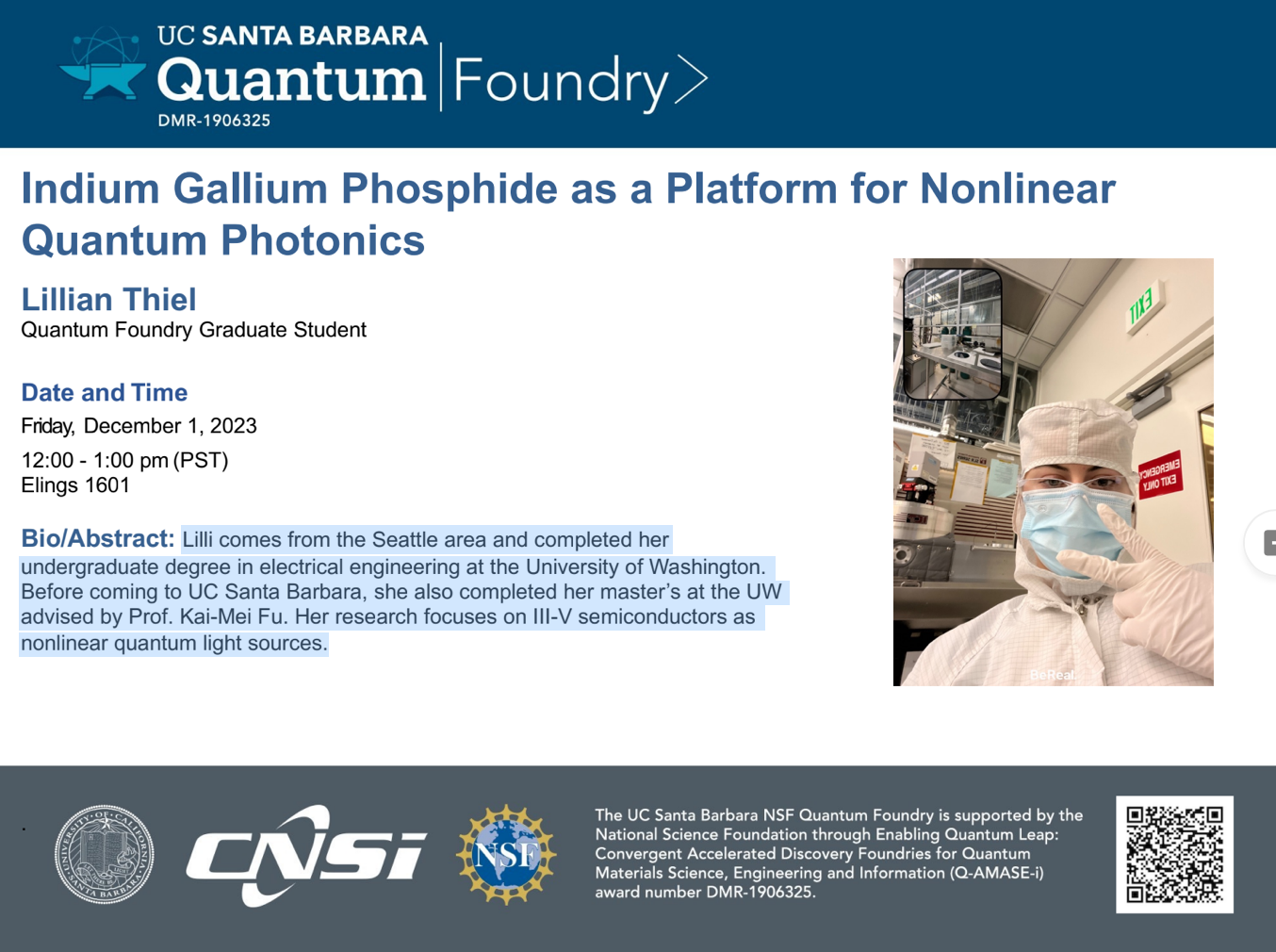
Lillian Thiel
Date: December 1, 2023
Indium Gallium Phosphide as a Platform for Nonlinear Quantum Photonics
Lilli comes from the Seattle area and completed her undergraduate degree in electrical engineering at the University of Washington. Before coming to UC Santa Barbara, she also completed her master’s at the UW advised by Prof. Kai-Mei Fu. Her research focuses on III-V semiconductors as nonlinear quantum light sources.

Lillian Hughes
Date: November 17, 2023
Creating Coherent Spin Systems in PECVD grown Diamond for Enhanced Quantum Sensing and Simulation
Lillian received a B.S. in Interdisciplinary Physics with a concentration in Chemistry from the University of Richmond in 2019, after which she joined the Materials Department at UCSB. Lillian is co-advised by Ania Jayich and Kunal Mukherjee and studies the growth of high-quality diamond for hosting solid state qubits like the nitrogen-vacancy center. In this talk, she will present recent work developing growth and defect engineering on the (111) diamond plane for applications in quantum metrology.
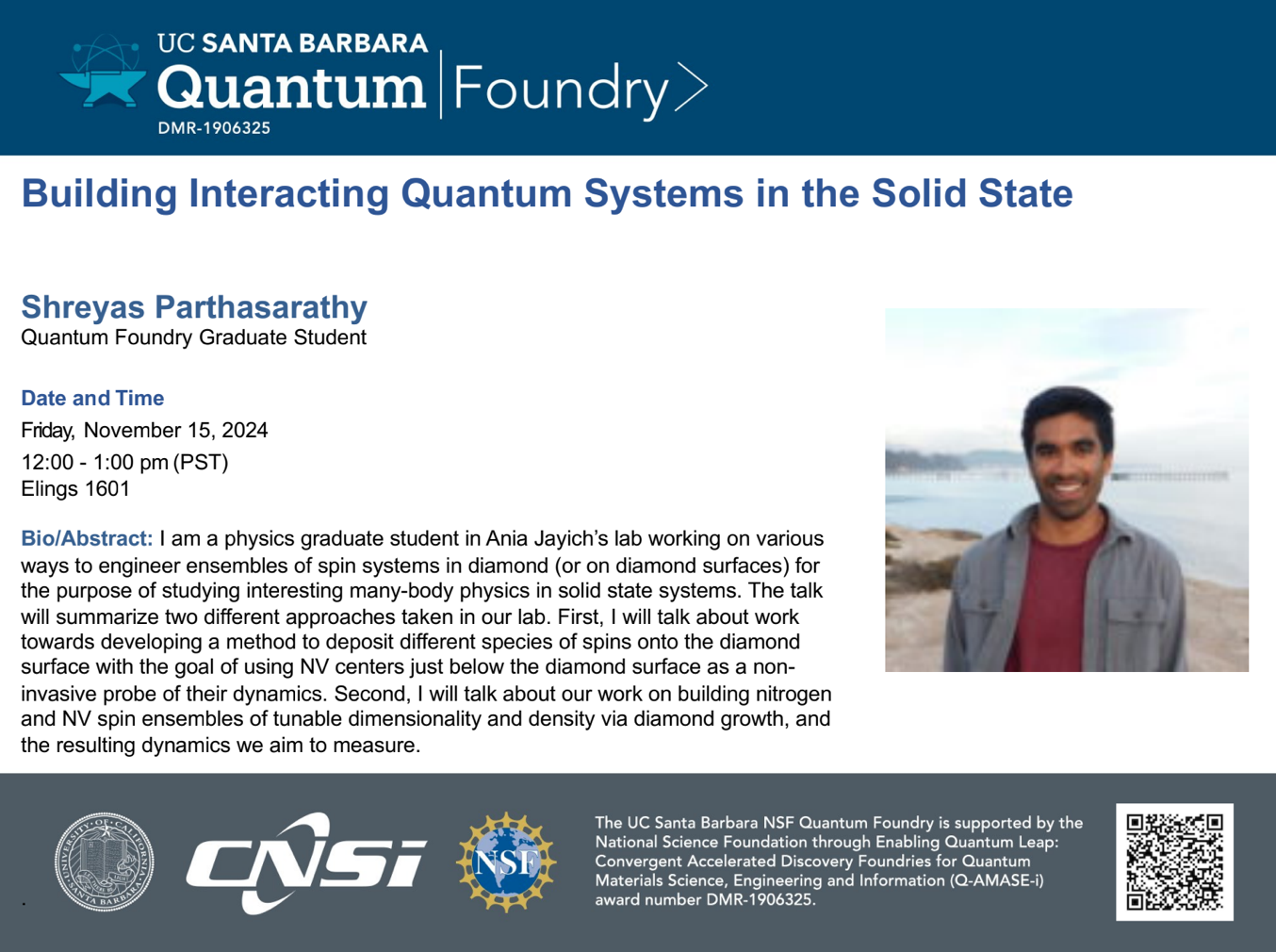
Shreyas Parthasarathy
Date: November 15, 2024
Building Interacting Quantum Systems in the Solid State
I am a physics graduate student in Ania Jayich’s lab working on various ways to engineer ensembles of spin systems in diamond (or on diamond surfaces) for the purpose of studying interesting many-body physics in solid state systems. The talk will summarize two different approaches taken in our lab. First, I will talk about work towards developing a method to deposit different species of spins onto the diamond surface with the goal of using NV centers just below the diamond surface as a non-invasive probe of their dynamics. Second, I will talk about our work on building nitrogen and NV spin ensembles of tunable dimensionality and density via diamond growth, and the resulting dynamics we aim to measure.
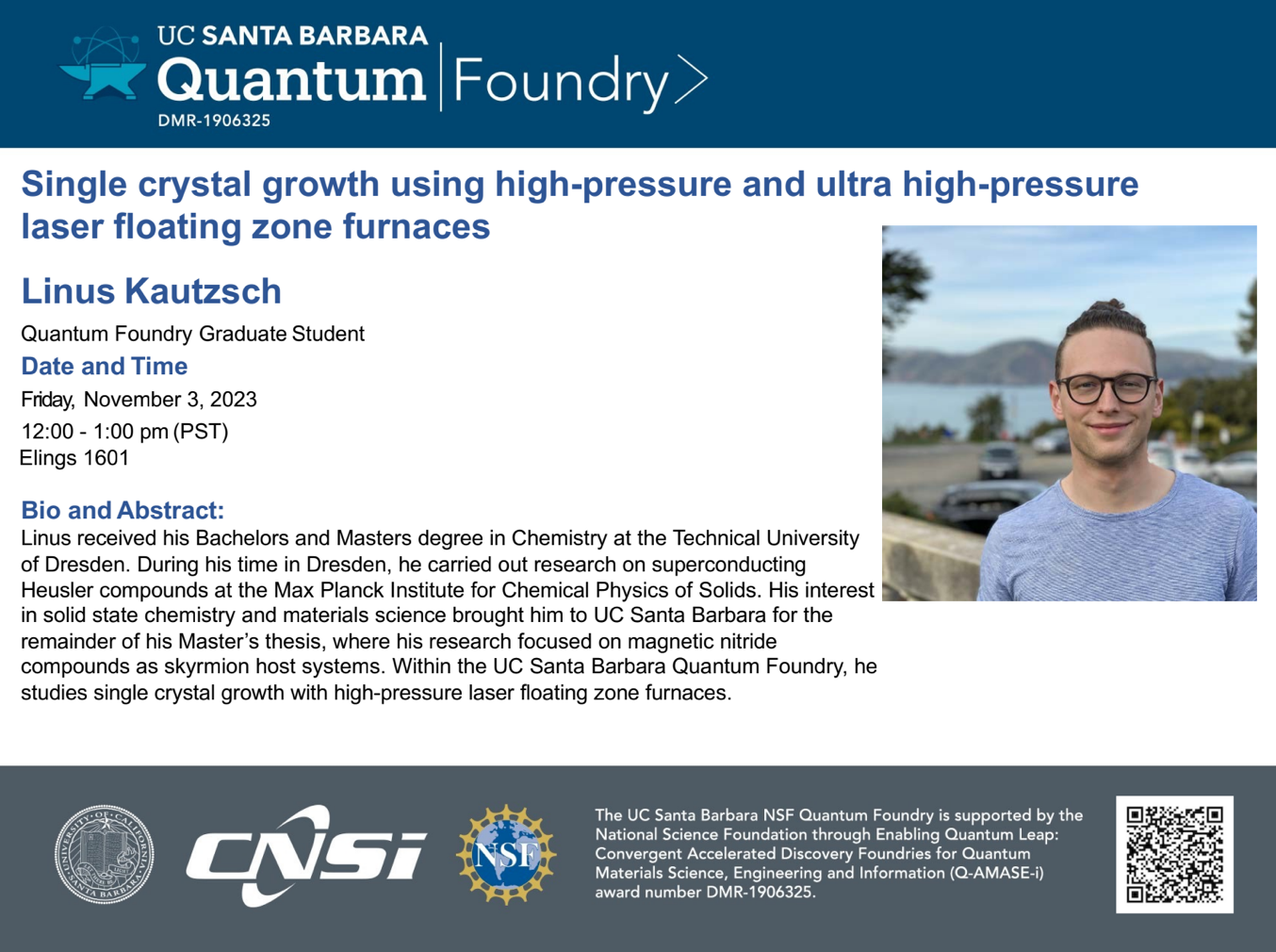
Linus Kautzsch
Date: November 3, 2023
Single crystal growth using high-pressure and ultra high-pressure laser floating zone furnaces
Linus received his Bachelors and Masters degree in Chemistry at the Technical University
of Dresden. During his time in Dresden, he carried out research on superconducting
Heusler compounds at the Max Planck Institute for Chemical Physics of Solids. His interest
in solid state chemistry and materials science brought him to UC Santa Barbara for the
remainder of his Master’s thesis, where his research focused on magnetic nitride
compounds as skyrmion host systems. Within the UC Santa Barbara Quantum Foundry, he
studies single crystal growth with high-pressure laser floating zone furnaces.

Jayameenakshi Venkatraman
Date: October 20, 2023
Floquet engineering with superconducting circuits
In the quantum world, it seems there is always a path to escape from a trap since energy is not conserved on very short time scales, allowing quantum fluctuations to overcome an energy barrier. The tunnel effect is the most striking manifestation of this quantum escape game and has no classical counterpart. However, counterintuitively, if a second path is also available, the two paths can be arranged so that they destructively interfere with each other, thus blocking the escape. This interference is also a quantum- mechanical feature and enters here to null out the freedom provided by quantum tunneling. Furthermore, the two paths can also be arranged so that they interfere constructively, now enhancing tunneling instead of suppressing it. Thus, by controlling the phase difference between the two paths, one can control the intensity of tunneling in a way that is completely independent of the barrier height, a favorable situation with applications in quantum computation, and in molecular and nuclear physics. Our experiment has for the first time quantitatively demonstrated this interference effect in a controlled tunneling double-well system.
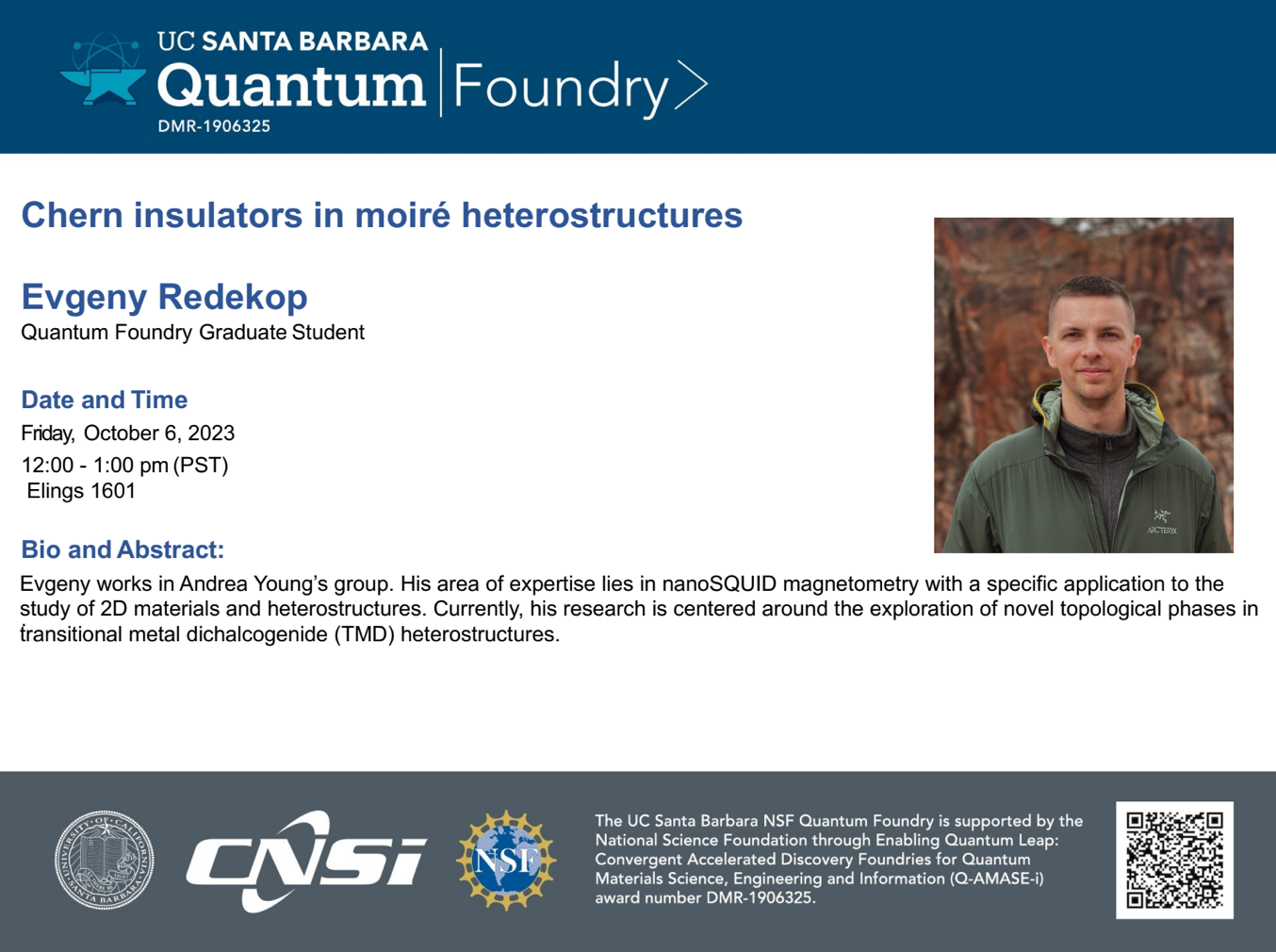
Evgeny Redekop
Date: October 6, 2023
Chern insulators in moiré heterostructures
Evgeny works in Andrea Young’s group. His area of expertise lies in nanoSQUID magnetometry with a specific application to the study of 2D materials and heterostructures. Currently, his research is centered around the exploration of novel topological phases in transitional metal dichalcogenide (TMD) heterostructures.
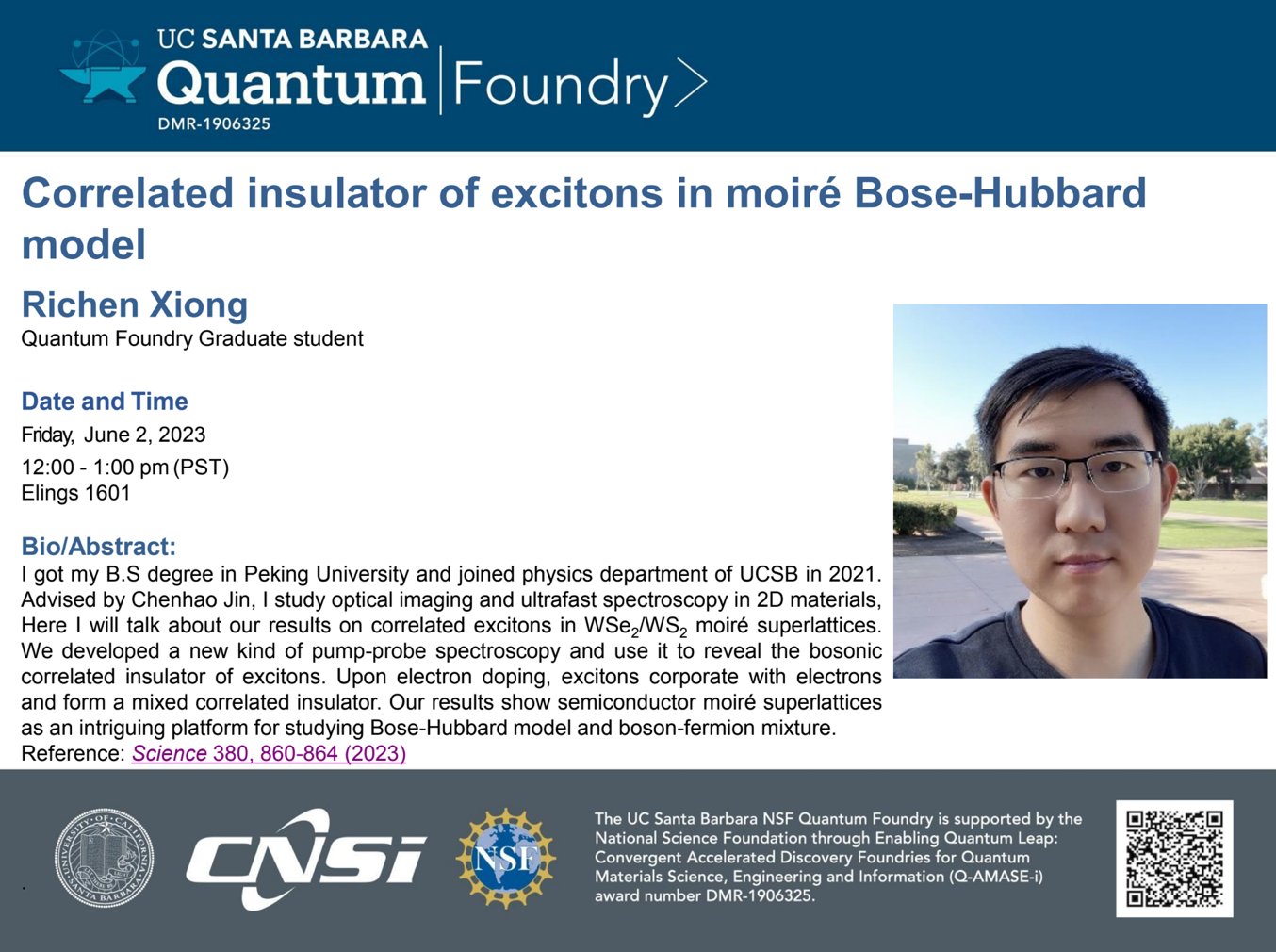
Richen Xiong
Date: June 2, 2023
Correlated insulator of excitons in moiré Bose-Hubbard model
I got my B.S degree in Peking University and joined physics department of UCSB in 2021.
Advised by Chenhao Jin, I study optical imaging and ultrafast spectroscopy in 2D materials,
Here I will talk about our results on correlated excitons in WSe2/WS2 moiré superlattices.
We developed a new kind of pump-probe spectroscopy and use it to reveal the bosonic
correlated insulator of excitons. Upon electron doping, excitons corporate with electrons
and form a mixed correlated insulator. Our results show semiconductor moirésuperlattices
as an intriguing platform for studying Bose-Hubbard model and boson-fermion mixture.
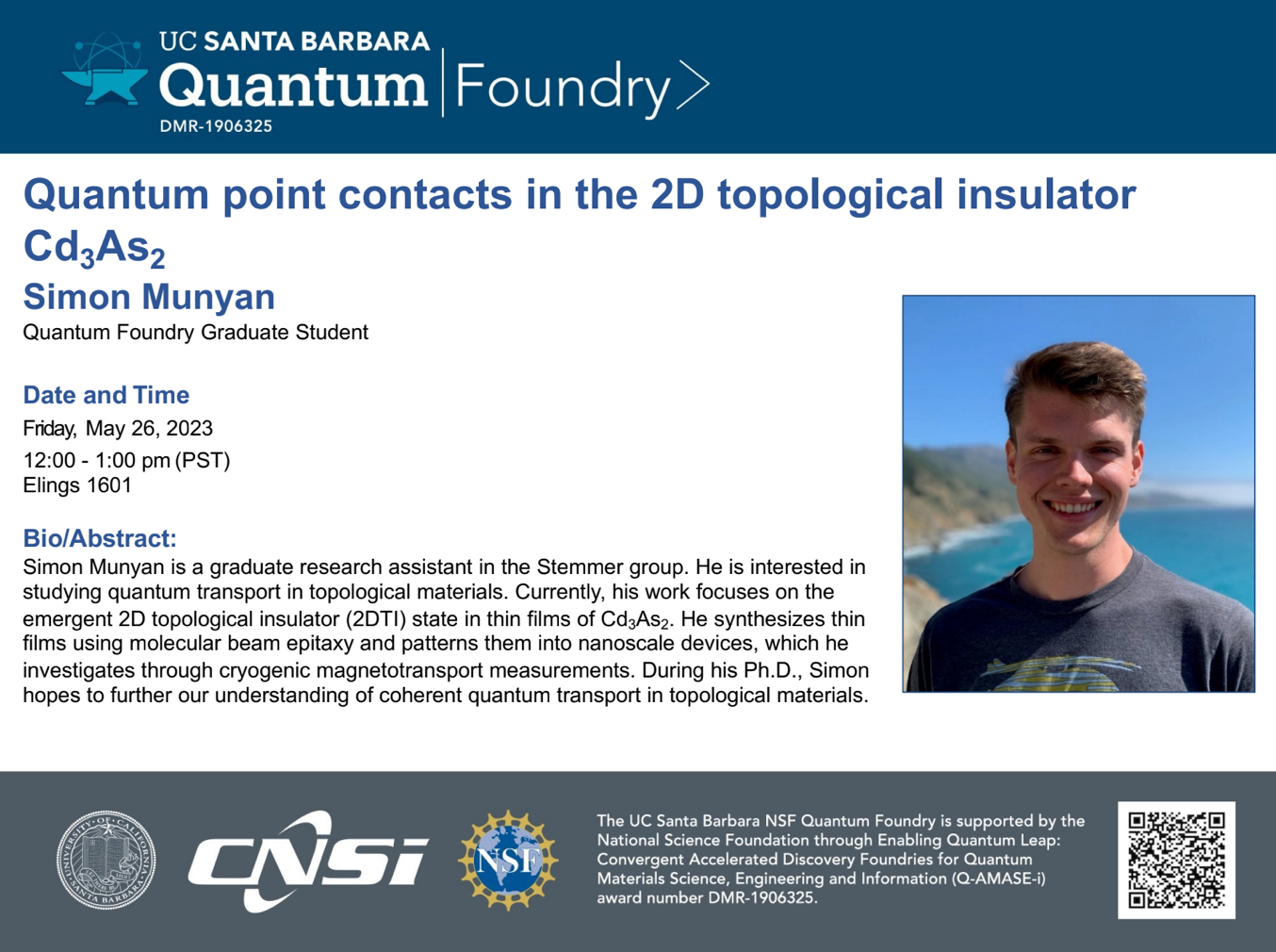
Simon Munyan
Date: May 26, 2023
Quantum point contacts in the 2D topological insulator Cd3As2
Simon Munyan is a graduate research assistant in the Stemmer group. He is interested in
studying quantum transport in topological materials. Currently, his work focuses on the
emergent 2D topological insulator (2DTI) state in thin films of CdaAs2. He synthesizes thin
films using molecular beam epitaxy and patterns them into nanoscale devices, which he
investigates through cryogenic magnetotransport measurements. During his Ph.D., Simon
hopes to further our understanding of coherent quantum transport in topological materials.